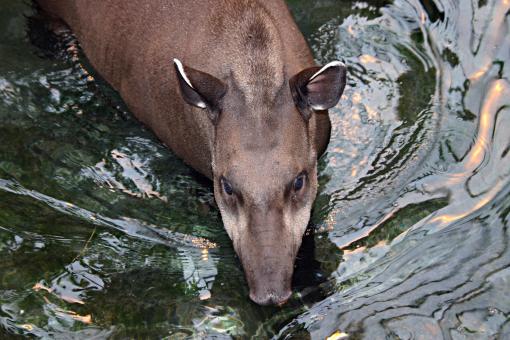ANIMAL: South American/Brazilian/Lowland Tapir Tapirus terrestris Type of Animal: Tapir Habitat: Forests, grasslands, swamps/swampy areas, hillside areas, savanna, waterways, wetlands, areas near water, rivers, lakes, ponds, mountainous areas (as high as 14,763.78 ft), woodlands, shorelines, areas w/ salt, lowlands, shrublands Location(s): E Colombia, E Ecuador, E Peru, Venezuela, Guiana Shield, most of Brazil except far SE, N & E Bolivia, Paraguay, NE Argentina Appearance: Dark brown, lighter in face, noticeable snout, low erect crest running from crown down back of neck, round dark ears w/ distinct white edges. Newborns dark brown w/ small white spots/stripes (almost like watermelon w/ legs), spots/stripes fade completely around 6 months Food/Diet: Seeds, fibers, leaves, fruit, stems, twigs, grasses, flowers, bromeliads, buds, shoots, branches, berries, aquatic plants, grains, wood, nuts, bark, vegetables, sprouts Status in Wild: Threatened Conservation: Breeding in zoos & wildlife parks Lifestyle: Solitary, though sometimes found in male-female pairs Additional Info: Called: Male: Bull Female: Cow Young: Calf Group: Pair Weight: Male: 352.74-551.16 lbs Female: 396.83-650.36 lbs Young: 100 lbs Gestation: 13 months Life Span: 25-30 years Height: Male: 2.75-3.67 ft Female: 2.75-3.83 ft Body Length: Male: 6.25-6.69 ft Female: 7.25 ft Tail Length: 2-4 in, same for both sexes Main predators are jaguars, pumas, crocodilians, anacondas, & bush dogs. Very elusive & hard to find in wild due to often nocturnal/crepuscular habits. Tough skin for protection from predators-will flee into water, or in case of females w/ calves, attack w/ canine teeth. Due to diet, play important role as seed dispersers-sometimes called “gardeners of the forest” for this role. Threatened due to deforestation, habitat loss, hunting for meat/sport/hide, agriculture, flooding from hydroelectric projects, cattle grazing, & illegal wildlife trade. Excellent swimmers, using snout as snorkel. Besides being used as snorkel, snout also used to obtain food since it’s prehensile. Splayed hooves come in handy when walking through soggy ground. Calves stay w/ mom for 1-2 years. Largest terrestrial mammal in Amazon. Mark territory by spraying urine on plants/other objects. Fun Fact(s): Can eat up to 75 lbs of food a day. Generally docile unless provoked or female protecting calf. Canine teeth quite capable of biting arm off. Though they might look like pigs, closest relatives horses & rhinos. Can stay underwater for up to 7 minutes.
